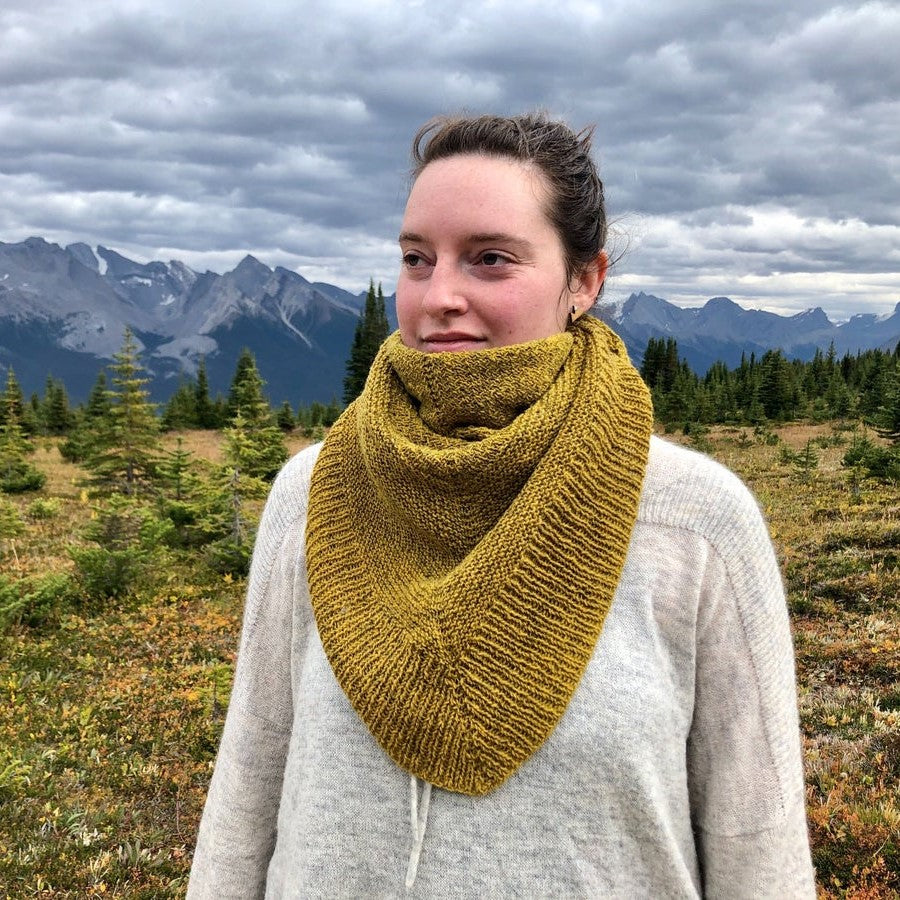Kalea Turner-Beckman should be no stranger to anyone in the Edmonton knitting scene. A co-founder of the Alberta Yarn project and passionate natural dyer, she has been working to connect Albertan yarn with Albertan crafters since 2014. An accomplished knitter, she is working on a Master Spinner designation. And yes, she also weaves!
Kalea currently produces her own Luddite Yarn brand. She personally sources the fleeces from local farms, prepares it for processing, has it milled, and then dyes it using natural dyes, many of which she forages from her surroundings or saves from food waste.
Gather collaborated with Kalea on a batch of local yarn dyed a beautiful range of strong yellows and oranges with simple onion skins! Kalea also created Onion Skin Dye Kits so that you can experience the magic of creating colourful yarn in your own kitchen.
We caught up with Kalea to talk why natural dyes give her joy, the environmental impact of food waste, and her past life as an anarchist dumpster diver.

Gather: When you did you get into natural dyes?
Kalea: I had been dabbling with natural dyes since around 2015, the first year of the Edmonton Resilience Festival. It was put on by the Local Good. They spearheaded a festival around sustainability and local living, green living. I took a natural dye workshop there from Deb Merriam, who is big in the rug hooking world and part of the Focus on Fibre Arts organization. She introduced me to natural dyes, and we were using kitchen scraps--onion skins and red cabbage. At the time I was running the Alberta Yarn project, and we sourced the yarn for the workshop. It was my first time natural dyeing and I loved it.
Then I took a course with Megan Samms out near Slave Lake. It was a collaboration between the Provincial Park and Megan Samms called Wildcrafting Colour. We learned how to weed invasive species and use them for dye. That was in 2017, and that was when I felt like this is my calling, I need to do natural dye.
Gather: So what is it about natural dye that takes it from an interesting technique or material source to the level of calling?
Kalea: I am really passionate about using waste. Obviously I love the colours, and the creativity of it is super fulfilling for me, but turning waste into something useful gives me joy. I don’t really know where the joy comes from. A funny story from my childhood that I like to tell is that I was really passionate about litter when I was a kid. I’ve always been an environmentalist and when I was little I was really worked up about litter. I would spend my recess walking around the yard picking up litter. I’m an introvert... I think it was a way to get away from the crowd of kids and take a quiet walk. The secretary noticed me and gave me a pair of plastic gloves and a trash bag so I could keep picking up litter without getting my hands dirty.
And then I was a dumpster diver in my early twenties… I got in with anarchist environmentalists in university and was doing direct action around food waste, and that was also a really joyful thing for me. Coming home with a big bag of perfectly good fruit and dinner that would have gone to the landfill otherwise, that was really exciting. And eventually to realize that I could incorporate those same passions and activities into my crafting life was amazing. I went from dumpster diver to natural yarn dyer.
Gather: So the yarn you’ve dyed and the yarn kits you’ve made are dyed with onion skin. Can you talk about what you love about onion skin dyeing?
Kalea: I really love the vibrant colours that you can get with onion skins. The depth of the golden orange is pretty special. The green that I get with the iron is really beautiful as well.
I also really love the image of Kim and Ang and the rest of you going into the grocery store and taking the onion skins that the store thinks are garbage from underneath the onions! [Editor’s note: the Gather Team took turns gathering all the onion skins we could find at various grocery stores to collect enough for Kalea to dye this yarn.]
It’s a really funny image. It evokes the same joy that I feel taking things out of the garbage, because it would have just been thrown out. The subversive nature of it is really fun to me. In most areas of my life I’m a rule follower, but the ethics of environmentalism allows me to get past that. But maybe that’s also why the subversiveness of breaking the rules with dyes for me is a great outlet… it frees me from my normal responsibility.

Gather: Are onion skins good for beginners?
Kalea: They’re really good for beginners. Onion skins are something that beginners often work with. You don’t need a separate set of pots because it’s edible, and you can actually do it without mordanting [using a chemical to help bind the dye to the yarn]. The kits for Gather have mordant in them because it makes the dye more colourfast. But it does attach to the yarn on its own. So it’s an easy project for kids or weekend craft dabblers, and you get a result quickly and easily. Add in the mordant and you also get a true colourfast and lightfast long term stable dye.
Gather: Is there something particularly fun about kitchen scraps for you? Or something important about working with food waste?
Kalea: There’s just so much food waste! It is mind boggling. Especially when I’m working with avocados and other food that we’re importing from far away. How much energy has gone into growing that avocado and transporting it here… and then we just throw useful parts of it away? After we’ve FLOWN it here? It boggles my mind. You get a beautiful pink colour from the pits and the skins. With onions obviously they aren’t coming from as far away, but still, if we are putting the energy into growing these, so we may as well use all of them.
My partner gets frustrated because I take so long chopping an onion when I’m cooking. First I take off the outer layer that’s good for dyeing and I put it in the dedicated onion skin jar I keep in the kitchen to save for later. And then I take the leathery layer and the tops and the bottoms and I put those in a bag in the freezer for making stock. I also save like my carrot tops and peelings for stock. So when I roast a chicken or have some meat bones I can put them in my slow cooker with all my saved onion bits. And THEN I chop the onion. When I’m cooking with onions it’s just the very end bit of the roots that goes in the garbage. Or in the compost in the summer. I live in an apartment building that has a community garden in the back. The management company was turning an unused tennis court into a community garden. So I’ve got a little garden space and there’s someone who is in the building who has taken the Master Composter through the City who manages a communal compost for us. The onions go into making soil that we share with each other. So I really get the most out of an onion.
To see just one of the amazing things Kalea does with onions, check out the Onion Skin Dyed Hill & Aran Sample Gradient Pack that she made using the onion skins that the Gather Team collected. Or if you’d like to put your own kitchen waste to good use, try out her Dyeing with Onion Skins DIY Kit!

